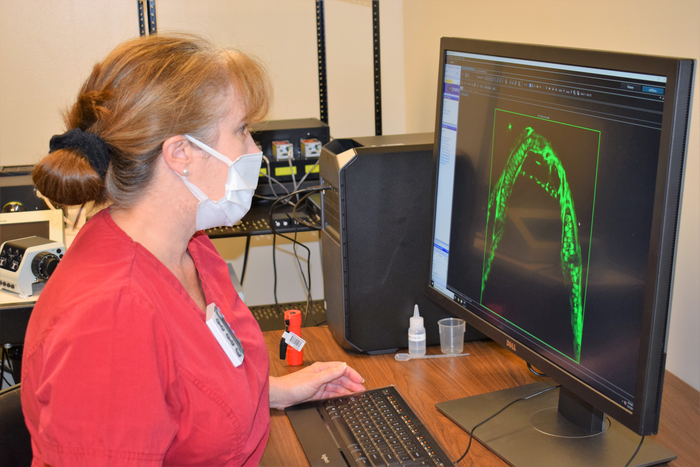Greenwood, SC (December 8, 2021) – Greenwood Genetic Center (GGC) researchers are reporting the discovery of a mechanism that contributes to the tissue phenotypes seen in PMM2-CDG, the most common of the congenital disorders of glycosylation (CDGs).

Credit: Greenwood Genetic Center
Greenwood, SC (December 8, 2021) – Greenwood Genetic Center (GGC) researchers are reporting the discovery of a mechanism that contributes to the tissue phenotypes seen in PMM2-CDG, the most common of the congenital disorders of glycosylation (CDGs).
CDGs are a group of over 130 rare genetic disorders caused by defects in the glycosylation of lipids and proteins. The phenotypes are variable, but often impact multiple body systems and involve neurological features. Patients with PMM2-CDG typically display hypotonia, developmental delay and intellectual disability, growth delays, movement abnormalities, and skeletal anomalies.
Using a zebrafish model of PMM2-CDG, GGC’s Heather Flanagan-Steet, PhD, and her team of collaborators found that defects in the processing of N-cadherin, a protein that helps control cell adhesion, are responsible for the craniofacial and motility abnormalities seen in PMM2-CDG.
“Half of all proteins in the human body are glycosylated, so it is very difficult to mechanistically probe this heterogeneous group of disorders,” said Flanagan-Steet, Director of Functional Studies at the Greenwood Genetic Center. “Finding the hypoglycosylated protein responsible for this CDG phenotype is like finding the needle in the haystack, but our novel approach to this disorder allowed us to not only identify this culprit, but also test therapeutic interventions.”
Where most prior studies in CDGs have involved the analytical chemistry approach of identifying glycosylated proteins first followed by interrogating them for a possible connection to the disorders, Flanagan-Steet said that their ‘top-down approach’ of creating a zebrafish model is what accelerated the discovery.
“We studied the phenotype in the PMM2-CDG zebrafish models and let the biology tell us where to go,” she said. “The biology of the phenotype suggested possible pathways that might be disrupted which is what led us to N-cadherin.”
N-cadherin processing allows for the adhesive properties of cells to fluctuate throughout normal development. When that process is disrupted, often through the altered expression of multiple proteases that control N-cadherin processing, the PMM2-CDG phenotype emerges. In the fish, that meant cartilage defects that led to craniofacial abnormalities and aberrant motility seen through altered swimming behaviors.
The researchers also found that by inhibiting furin proconvertases, one category of proteases that catalyze N-cadherin processing, multiple cellular and molecular phenotypes, including the cartilage and craniofacial defects in the zebrafish, could be rescued.
“By inhibiting the furin, we were able to improve the cartilage phenotype in over half of the fish studied suggesting that changes in the activity of these proconvertases initiate a cascade of events that leads to the skeletal disease in PMM2-CGG,” said Flanagan-Steet. “This exciting outcome suggests possible nodes of therapeutic intervention for future studies, and most importantly provides hope for families around the world who have been impacted by this rare disease.”
“This type of discovery represents one of the important next phases in CDG research – unraveling the elusive pathogenesis of these disorders by finding the proteins in the cell that are impacted by abnormal glycosylation,” said Richard Steet, PhD, GGC’s Director of Research. “We are also expanding our efforts to identify genetic modifiers of CDGs with our colleagues at the Clemson Center for Human Genetics (CHG). This will provide yet another promising avenue to therapies”.
This work is published by JCI Insight with collaborators from the University of Georgia, Sanford Children’s Health Research Center, UT Southwestern Medical Center, and the Medical University of South Carolina.
Funding from the National Institutes of Health, National Cancer Institute, and The Rocket Fund supported the research. Dr. Flanagan-Steet’s CDG research program is also supported by the NIH COBRE grant between the Greenwood Genetic Center and the Clemson Center for Human Genetics.
About Greenwood Genetic Center
The Greenwood Genetic Center (GGC), founded in 1974, is a nonprofit organization advancing the field of medical genetics and caring for families impacted by genetic disease and birth defects. At its home campus in Greenwood, South Carolina, a talented team of physicians and scientists provides clinical genetic services, diagnostic laboratory testing, educational programs and resources, and research in the field of medical genetics. GGC’s faculty and staff are committed to the goal of developing preventive and curative therapies for the individuals and families they serve. GGC extends its reach as a resource to all residents of South Carolina with satellite offices in Charleston, Columbia, Florence and Greenville. For more information about GGC please visit www.ggc.org.
###
Journal
JCI Insight
DOI
10.1172/jci.insight.153474
Method of Research
Experimental study
Subject of Research
Animals
Article Title
Protease-dependent defects in N-cadherin processing drive PMM2-CDG pathogenesis
Article Publication Date
16-Nov-2021




